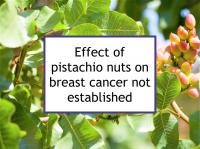Pistachio (Pistacia vera) nuts are an excellent source of fiber (especially insoluble fiber), potassium, and vitamin E (especially gamma-tocopherol, as described below). Pistachio nuts are also a very good source of catechins, lutein, melatonin, manganese, thiamin, and vitamin B6, as well as monounsaturated fatty acids such as oleic acid.
Pistachio nuts are also a source of CoQ10, cyanidin-3-galactoside, folate, magnesium, myricetin, and resveratrol, most of which have been shown to have chemopreventive properties. However, pistachios also incorporate a significant amount of copper.
Breast cancer-related effects of eating pistachio nuts
Higher intake of tree nuts has been linked to lower breast cancer risk, and estrogen receptor negative (ER-) breast cancer in particular, although not all studies are in agreement. There is little specific evidence concerning pistachio nut consumption and breast cancer risk. One study reported that pistachio kernel extract reduced hormone receptor positive (ER+/PR+) breast cancer cell viability in a dose and time dependent manner. High intake of dietary fiber and vitamin E (but not vitamin E supplements) have both been reported to be associated with reduced risk of breast cancer. In addition, pistachio nuts are a rich source of beta-sitosterol, which competes with the absorption of cholesterol from food (helping to lower cholesterol) and has also been reported to inhibit breast cancer cell viability, proliferation and tumor progression.
Melatonin
Melatonin protects against breast cancer in several ways, including by reducing aromatase activity within the breast, thereby decreasing estrogen production and protecting against ER+ breast cancer. Melatonin has also been found to be effective in reducing tumor growth, cell proliferation, and angiogenesis in an animal model of triple negative breast cancer. In addition, melatonin has been reported to increase the anticancer effects of doxorubicin while reducing the doxorubicin-induced cardiotoxicity and chemo brain. Melatonin has also been shown to enhance the treatment effects of cisplatin, paclitaxel, radiotherapy and tamoxifen.
Gamma-tocopherol form of vitamin E
Vitamin E comprises a group of eight related vitamins, including four tocopherols (α, β, γ, and δ-tocopherol) and four tocotrienols (α, β, γ, and δ-tocotrienol). Alpha-tocopherol (α-tocopherol) is the most abundant form of vitamin E and is the isoform typically found in vitamin E supplements.
As noted above, pistachio nuts are an excellent source of gamma-tocopherol (γ-tocopherol), which has greater chemopreventive effects than alpha-tocopherol.
Copper
Pistachio nuts should be consumed in moderation since they contain a significant amount of copper (approximately 0.37 mg per ounce), which could contribute to angiogenesis and metastasis of breast cancer, especially in women with aggressive disease such as inflammatory breast cancer (IBC), triple negative (ER-/PR-/HER2-) or HER2-positive (HER2+) breast cancer. One 2024 study found that relatively high levels of copper in the urine of girls were associated with increased breast density two years after menarche. On the other hand, while copper appears to increase the risk of recurrence, it does not significantly heighten risk of primary breast cancer according to available evidence.
Although copper is a vital nutrient, women with breast cancer probably should not exceed the RDA (recommended dietary allowance) of approximately 0.9 mg unless they are anemic. High copper foods such as calf's liver and beef liver should be avoided. Copper intake should be reserved for foods with chemopreventive properties such as pistachio nuts and walnuts (which incorporate approximately 0.45 mg copper per ounce, but have exceptional anti-breast cancer properties).
Reasons for recommendation status
Foods are given the Different for different women recommendation status when they have varying effects on breast cancer based on breast cancer type, treatment or other factors. Pistachio nuts have a mostly beneficial anti-cancer profile, with a favorable mix of fat, fiber, vitamin E and phytochemicals. In addition, intake of tree nuts has been has been linked to lower breast cancer risk in population studies. On the other hand, pistachio nuts have relatively high levels of copper, which has the potential to promote breast cancer, and therefore should limit their consumption.
Additional comments
Since most pistachio nuts are sold roasted and salted, those who are concerned about their intake of sodium should seek out pistachios with no added salt.
Pistachio nuts and aflatoxin
The U.S. is the world's second largest producer of pistachio nuts (most of which are grown in California), whereas Iran is the largest producer. Turkey, Syria, and China also produce significant volumes. Pistachio nuts typically are infected to some extent with molds that produce aflatoxins, which are mutagenic, carcinogenic and teratogenic and cause immuno-suppression in humans. Aflatoxin B1 has been shown to cause liver cancer, especially in hepatitis B-positive individuals. While U.S. pistachio nuts generally contain very low levels of aflatoxins, non-U.S. pistachios sometimes contain unacceptably high levels. Dangerous levels have been reported in pistachio nuts produced in Iran and Morocco.
Pistachio nuts normally are dried soon after harvest to minimize shell staining and decay and to ensure safety. Pistachio nuts sold without the shell are much more likely to have a high level of contamination than pistachios sold inshell.
To maximize safety, select inshell pistachio nuts that have not been dyed red (the dye itself is not healthy and is sometimes used to cover up stains). Avoid eating any pistachios with stained or missing shells, that have a sour taste, or any signs of mold, excessive moisture or insect damage.
These factors suggest that pistachio nuts are best enjoyed (in moderation) if purchased inshell and organically grown in the U.S., with minimal salt added if roasted.
Sources of information provided in this webpage
The information above, which is updated continually as new research becomes available, has been developed based solely on the results of academic studies. Clicking on any of the underlined terms will take you to its tag or webpage, which contain more extensive information.
Below are links to 20 recent studies concerning this food and its components. For a more complete list of studies, please click on pistachio nut.
